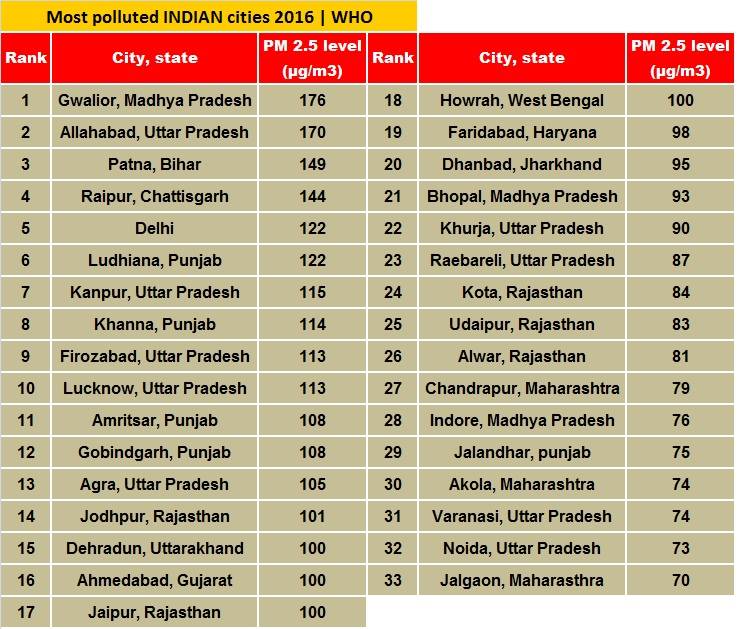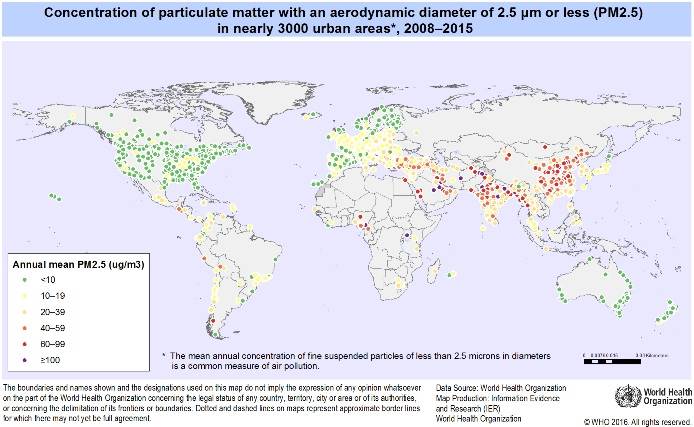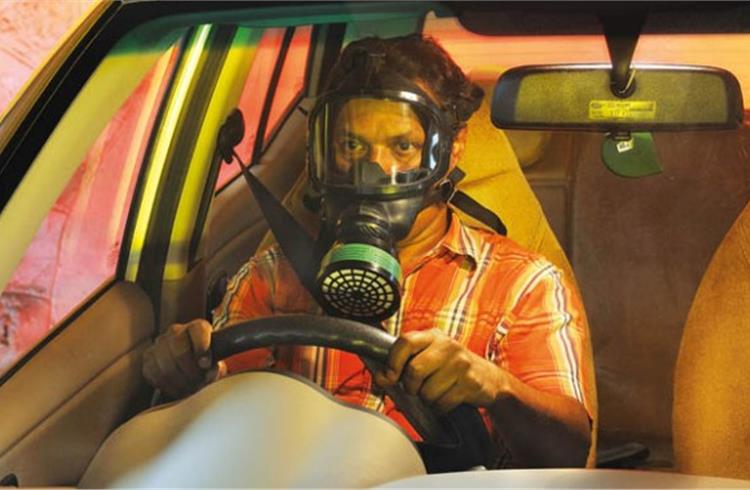India has the most polluted cities in the world: 33 out of 100
While New Delhi no longer tops the most polluted cities list, it keeps company with by 32 other Indian cities.
As per the World Health Organisation’s (WHO) latest report on ‘Ambient Air Pollution 2016’, India has the most polluted cities in the world. Out of the 100 most polluted cities in the world, India has 33, while it also contributes 22 cities to the top 50 most polluted ones.
In contrast, China, which has long been the most polluted country, features 27 cities in the top 100 list. Despite the rise in number of Indian cities, the country’s capital – New Delhi – is no more the most polluted city in the world. As per WHO 2014 data on air pollution, Delhi was the most polluted city reporting a mean annual PM 2.5 level of 153 µg/m3. However, within two years, the PM 2.5 level in the capital has gone down to 122 µg/m3, with Delhi now dropping to the 11th spot. The capital is thereby overtaken by Raipur (*144 µg/m3), Patna (*149 µg/m3), Allahabad (*170 µg/m3) and Gwalior (*176 µg/m3), the latter having the ignominy of being the most polluted Indian city and the second in the world. [*Annual mean PM 2.5 level].

In wake of the Delhi diesel ban and odd-even traffic scheme in December last year, Autocar Professional had said that Delhi wasn’t the only polluted city in India, with places like Patna, Gwalior, Raipur, Bangalore and Ahmedabad fast catching up with the capital. The latest WHO database confirms the news.
“Air pollution is a major cause of disease and death. It is good news that more cities are stepping up to monitor air quality, so when they take actions to improve it they have a benchmark,” says Dr Flavia Bustreo, WHO assistant-director general, Family, Women and Children’s Health. “When dirty air blankets our cities, the most vulnerable urban populations — the youngest, oldest and poorest — are the most impacted.”
Surprisingly none of the Indian metro cities like Mumbai, Chennai, Bangalore or Kolkata were among the top 100 most polluted cities globally. This verifies the fact that the highest urban air pollution levels are experienced in low-and middle-income areas.

Global urban air pollution trends
As per WHO, ambient air pollution contributes to 3 million/ 6.7% of all deaths globally. The latest data shows that Iranian city of Zabol is the most polluted in the world with a PM 2.5 level of 217 µg/m3. Apart from the four Indian cities mentioned above, the top 10 list included Riyadh and Al Jubail from Saudi Arabia, Cameroonian city of Bamenda and two Chinese cities – Xingtai and Baoding.
WHO’s statement says that more than 80% of people living in urban areas that monitor air pollution are exposed to air quality levels that exceed WHO limits. While all regions of the world are affected, populations in low-income cities are the most impacted.
The latest urban air quality database shows that 98% of cities in low- and middle income countries with more than 100,000 inhabitants do not meet WHO air quality guidelines. However, in high-income countries, that percentage decreases to 56%.
In the past two years, the database – now covering 3,000 cities in 103 countries – has nearly doubled, with more cities measuring air pollution levels and recognizing the associated health impacts.
As urban air quality declines, the risk of stroke, heart disease, lung cancer, and chronic and acute respiratory diseases, including asthma, increases for the people who live in them.
WHO was able to compare a total of 795 cities in 67 countries for levels of small and fine particulate matter (PM 10 and PM 2.5) during the five-year period, 2008-2013. PM 10 and PM 2.5 include pollutants such as sulfate, nitrates and black carbon, which penetrate deep into the lungs and into the cardiovascular system, posing the greatest risks to human health.

Reducing the toll on human health
Most sources of urban outdoor air pollution are well beyond the control of individuals and demand action by cities, as well as national and international policymakers to promote cleaner transport, more efficient energy production and waste management.
“Urban air pollution continues to rise at an alarming rate, wreaking havoc on human health,” says Dr Maria Neira, WHO director, Department of Public Health, Environmental and Social Determinants of Health. “At the same time, awareness is rising and more cities are monitoring their air quality. When air quality improves, global respiratory and cardiovascular-related illnesses decrease.”

Reducing industrial smokestack emissions, increasing use of renewable power sources, like solar and wind, and prioritizing rapid transit, walking and cycling networks in cities are among the suite of available and affordable strategies.
According to says WHO’s Dr Carlos Dora: “It is crucial for city and national governments to make urban air quality a health and development priority. When air quality improves, health costs from air pollution-related diseases shrink, worker productivity expands and life expectancy grows. Reducing air pollution also brings an added climate bonus, which can become a part of countries’ commitments to the climate treaty.”
During the World Health Assembly, May 23-28, the Member States will discuss a road map for an enhanced global response to the adverse health effects of air pollution.
Find out the live air quality in your city by clicking here
Also read: Indian Auto industry calls for clear roadmap to tackle pollution
RELATED ARTICLES
Uniproducts India targets 15% growth till FY2027, eyes new EV OEMs for NVH parts
The Noida-headquartered company, which is a leading manufacturer of roof liners, floor carpets, sound insulation materia...
Ford to build more EV software capability at Chennai tech hub
Ford Business Solutions India, which currently employs 12,000 personnel set to add 3,000 more; Ford, which is known to b...
ASK Automotive to set up JV with Aisin to sell aftermarket parts for cars
Ask Automotive will have 51% of the equity of the joint venture to be set up with Aisin Asia (Thailand) Company and Aisi...





 By Takshak Dawda
By Takshak Dawda
 13 May 2016
13 May 2016
 31789 Views
31789 Views









